News
Music Fountains in Kazakhstan: A Journey Through History and Design
- 2025-05-07
A Symphony of Water and Light: Stunning Musical Fountains across Kazakhstan
Kazakhstan boasts several stunning musical fountains that combine water, light, and music to create mesmerizing spectacles. Here are some notable examples:
Singing Fountain in Astana
Located near the iconic Baiterek Monument along Nurzhol Boulevard in Astana (formerly Nur-Sultan), the Singing Fountain is a favorite among locals and tourists. In the evenings, water jets illuminated in various colors ‘dance’ to classical music, offering a delightful performance. This fountain operates during the warmer months, typically from May to September.

Astana Expo 2017 Musical Fountain
As part of the Astana Expo 2017, a monumental fountain was designed to captivate visitors with water displays synchronized to music and lighting effects. Covering a surface area of 2,630 m² with a water volume of 1,618 m³, the fountain featured vertical, dancing, and rocket jets shooting water up to 30 meters high, complemented by colored flames and a spectrum of lights.
The musical dancing fountain project at the Kazakhstan Expo was jointly constructed by Germany, Turkey, and China. In this project, Changsha Himalaya Music Fountain company, as the sole supplier from China, provided various fountain equipment, including 24 sets of fireball fountains, 42 sets of water-fire fountains, 2 sets of swinging UFO fountains, and 10 sets of seagull fountains.
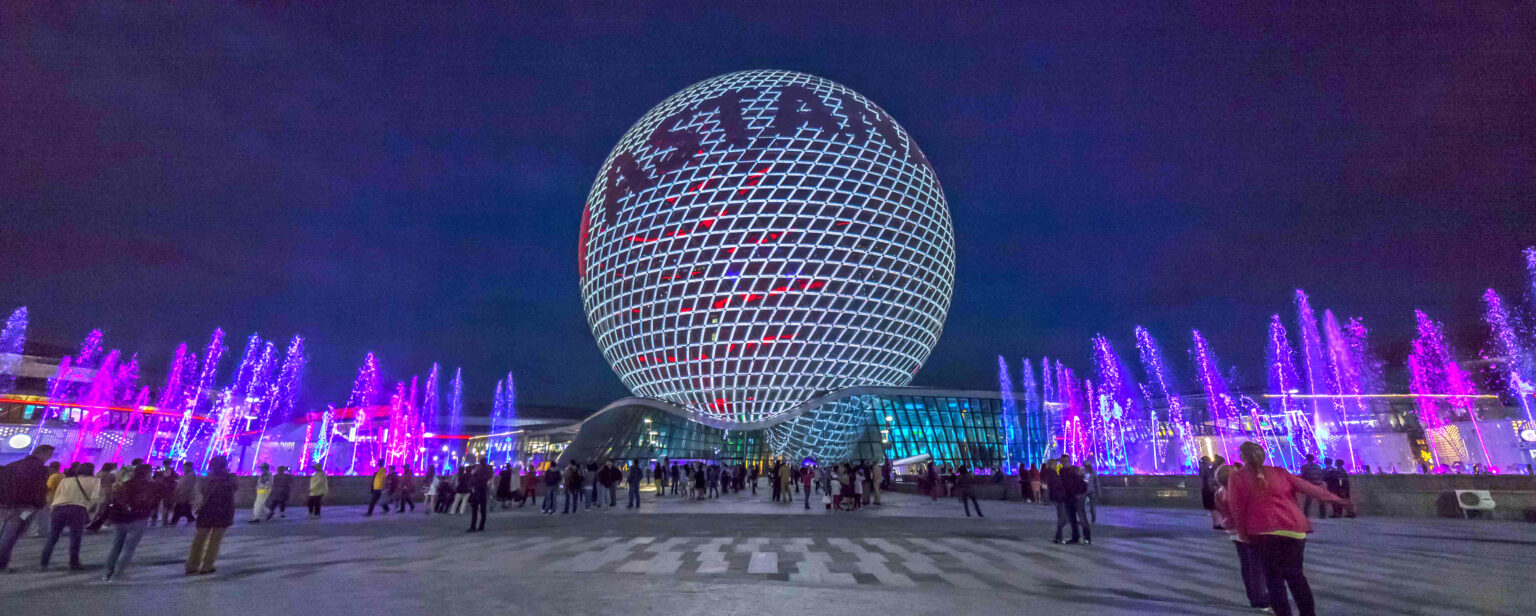
Light and Music Fountain with Laser and Fire in Aktobe, Kazakhstan
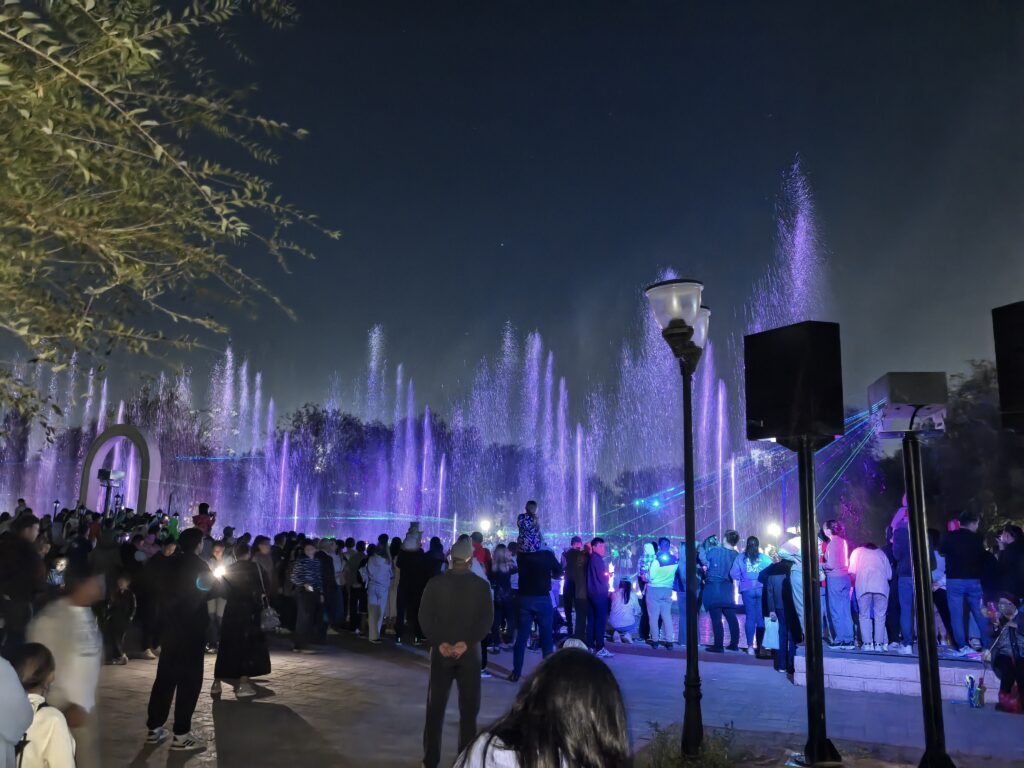
The musical fountain project in Kazakhstan has been meticulously designed and produced by Changsha Himalaya Music Fountain Company. The entire fountain system is connected by two sets of advanced floating equipment, with a total length of 270 meters. The design integrated dozens of unique water features, such as UFO shapes, fire jets, swinging flames, dynamic running fountains, and laser water shows, making the fountain display more diverse and breathtaking.
These fountains exemplify Kazakhstan’s blend of art, technology, and public space, offering both residents and visitors enchanting experiences that highlight the country’s commitment to cultural and technological innovation.
The history of fountain design in Kazakhstan
The history of fountain design in Kazakhstan reflects the country’s unique blend of nomadic heritage, Soviet influence, and modern aspirations. Though not as fountain-centric as some European nations, Kazakhstan’s fountains have grown in significance, especially in urban planning and architectural aesthetics. Here’s a quick journey through the stages of fountain development in Kazakhstan:
-Pre-Soviet Era
Nomadic lifestyle = no decorative fountains.
Water sources (wells, springs) were functional, not ornamental.
-Soviet Period
Fountains became urban symbols of progress.
Found in central squares, parks—especially in Almaty.
Style: monumental, modernist, with socialist and classical elements.
-Post-Independence (1991–2000s)
Focus on national identity and beautification.
Designs began incorporating Kazakh motifs and cultural elements.
-Modern Era
Cities like Astana feature tech-driven fountains (music, lights, interactivity).
Emphasis on symbolism, tourism, and eco-urban planning.

The unique blend of Culture and Technology that defines these fountains
The musical fountains in Kazakhstan are not just feats of engineering or visual spectacles—they’re vibrant expressions of the country’s evolving identity. Here’s how they beautifully blend culture and technology:
Cultural Soul Meets Modern Spectacle
Each fountain is choreographed to classical, national, or contemporary music, paying homage to Kazakhstan’s rich cultural tapestry. The use of traditional Kazakh compositions alongside global symphonies creates an auditory bridge between East and West, past and future.
Innovative Tech with Local Character
Advanced hydraulic and lighting systems allow water to “dance” in sync with music, while LED and flame effects add theatrical flair.
The Singing Fountain in Astana, for instance, is nestled within the capital’s architectural marvels, acting as a cultural beacon surrounded by monuments like the Baiterek Tower.
At Astana Expo 2017, the fountain was not just entertainment—it was a symbol of progress, using cutting-edge tech to reflect Kazakhstan’s global aspirations.
Public Art as Everyday Experience
Rather than placing culture in museums, these fountains bring it into public parks, boulevards, and plazas. Locals gather nightly to enjoy performances that are free, communal, and deeply immersive—technology making art accessible to all.
A Vision of Future Traditions
By combining ancestral melodies with synchronized jets and digital controls, Kazakhstan’s musical fountains show how traditions aren’t being replaced—they’re being reimagined through innovation.
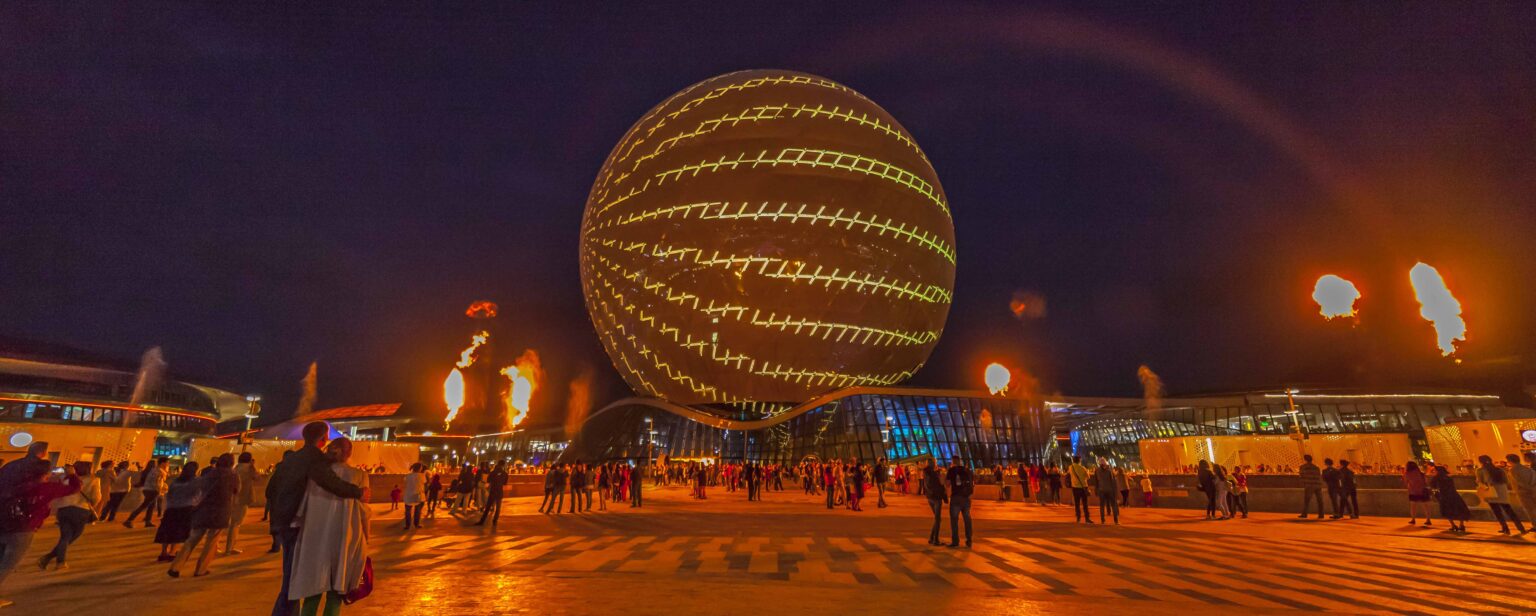
Beyond the Water: A Deep Dive into Fountain Design
Musical fountains are marvels of engineering where hydraulics, acoustics, and illumination come together in harmony. Here’s a breakdown of the key technical aspects behind their captivating performances:
Water Pressure and Jet Systems
Musical fountains rely on a range of pump-driven nozzles to create dynamic water displays:
Water Pressure:
High-performance pumps (often submersible) generate pressure ranging from 2 to 10 bar or more, depending on the desired height and type of jet.
Jet Types:
Vertical Jets: Shoot water straight up—can reach heights of 100m+.
Swing/Rotary Jets: Mechanically rotate or oscillate to produce sweeping arcs.
Dancing Jets: Use servos or stepper motors for real-time movement, synchronized with music.
Mist/Fog Nozzles: Add atmosphere or soften transitions between shows.
Other Special Fountain Effects: There are some other special popular fountain effects in a large water show such as fire effect, air-explosive fountain, swinging flame fountain etc.
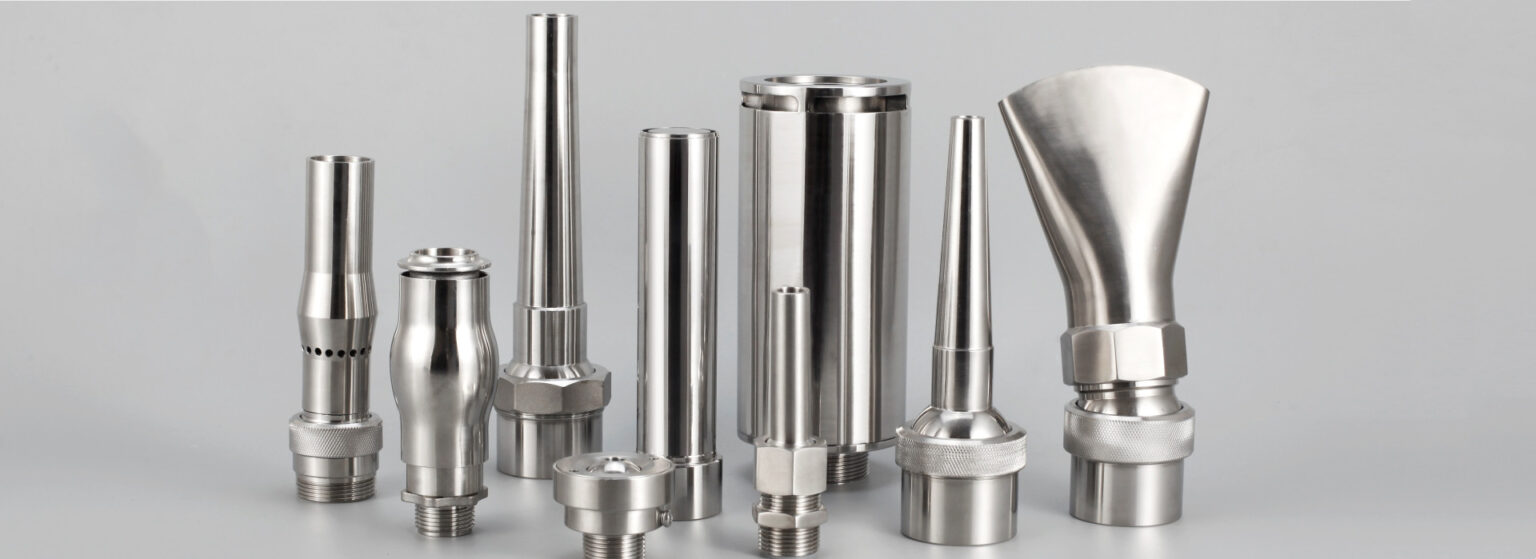
Control Systems:
Each jet may be controlled independently via programmable logic controllers (PLCs) or DMX-based control systems, allowing for intricate choreography.
Sound System Integration
High-Fidelity Outdoor Speakers:
Waterproof and weather-resistant systems are strategically placed for even sound distribution across large public spaces.
Synchronization:
Music tracks are digitally mapped to control signals for jets and lights.
Precision timing is key—typically achieved through MIDI or timecode synchronization.
Some systems allow real-time responsiveness, adapting water movements to live music.
Acoustics:
Fountain layouts are designed to minimize echo and distortion in open-air environments, often using directional speakers and sound-reflective materials.
.jpg)
Lighting Systems
LED Lighting:
The industry standard due to energy efficiency, color range (RGBW), and durability.
DMX Control:
Each light fixture is addressable via DMX512 protocol, allowing for precise changes in:
Color,Intensity,Strobe and fade effects,Synchronization with water and music cues
Underwater Fixtures:
Rated at least IP68 to withstand submersion, pressure, and continuous operation.
Advanced Effects:
Some setups include laser projection, video mapping, fire features, and even holographic mist screens to enhance the narrative.
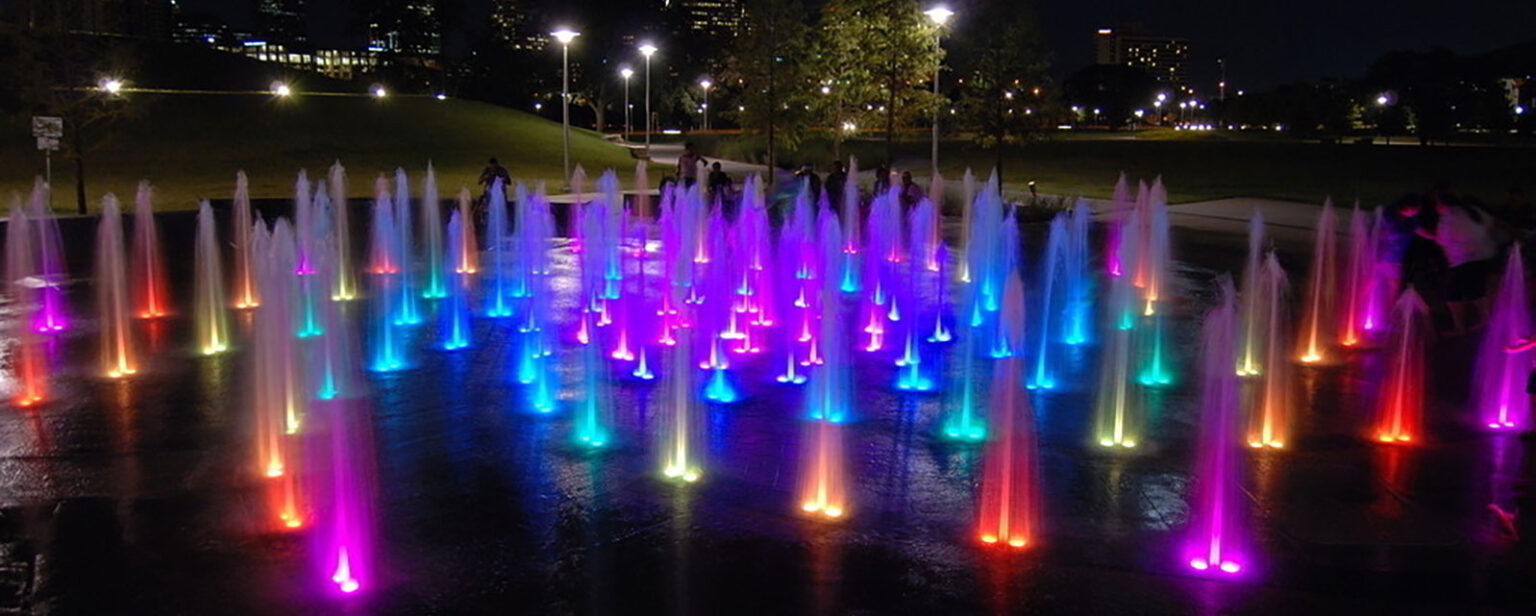
Central Control System
At the heart of it all is a show controller—a computer running custom software where engineers program each scene down to the millisecond. These controllers:
Orchestrate pumps, valves, lights, and audio playback.
Store multiple show profiles.
Can be managed remotely via touchscreen interfaces or even mobile apps.
Support Infrastructure
Water Recycling Systems: Use filtration and chemical treatments to recirculate water.
Sensors & Safety Mechanisms: Detect wind, water levels, or obstructions to pause or adjust the show automatically.
Power Supply Units (PSUs): Often housed in watertight enclosures near the fountain basin, ensuring stable voltage for all components.
The impact of water choreography on the viewer's experience
Water choreography is the emotional heartbeat of a musical fountain show. It’s not just about shooting water into the air; it’s about how movement, rhythm, and flow tell a story. Here’s a deep dive into its impact on the viewer’s experience:
Emotional Engagement Through Movement
Fluid motion mimics dance, evoking grace, excitement, or tension depending on tempo and arc.
Just like in ballet or modern dance, the “body language” of water—its pauses, bursts, or spirals—communicates mood.
When synced with music, water becomes a visual interpreter of sound, helping viewers feel the music more viscerally.
Example:
Slow, arching jets during a violin solo create a sense of longing or serenity. A sudden burst of vertical jets during a drum beat triggers adrenaline and awe.
Multisensory Synchronization Enhances Memory
Water choreography turns a song into an immersive 3D experience, activating multiple senses at once:
Visual: Light + water in motion.
Auditory: Surround sound and musical tempo.
Tactile: Mist or water spray on the skin.
This multisensory combination makes the moment more memorable and emotionally potent. Viewers often describe the experience as “magical” or “like watching music come to life.”
Timing and Surprise Elevate Drama
The use of suspense and release in choreography (e.g., building tension with rising jets, then a sudden explosion) mirrors cinematic pacing.
Well-timed transitions keep the audience engaged, shifting between quiet elegance and jaw-dropping spectacle.
Psychological Impact:
This rollercoaster of movement taps into the same emotional responses as a dramatic film or a powerful concert—eliciting awe, joy, nostalgia, or even tears.
Collective Experience Builds Community
In public spaces, choreographed fountains become shared experiences that bring people together—families, tourists, strangers.
The rhythm of the water often leads to spontaneous applause, gasps, or cheers, turning passive viewing into interactive emotion.
Cultural and Symbolic Resonance
When water choreography is based on local rhythms, folklore, or national anthems, it taps into collective memory and identity. For instance:
Circular jet patterns may echo traditional Kazakh dance formations.
Water spirals timed to a dombra solo (Kazakh lute) visually reinforce national heritage.
Water choreography transforms mechanical systems into storytelling instruments. It turns fountains from decoration into performance art, giving audiences an emotional, unforgettable journey that blends music, motion, and light into one cohesive spectacle.
A Future of Flow: Looking Ahead at Fountain Innovations
Emerging trends in fountain technology
Fountain design has moved far beyond fixed water shows. As technology evolves, so do the ways we interact with public water art. Here are the emerging trends in fountain technology that are pushing the boundaries of creativity and immersion:
Augmented Reality (AR): Making the Invisible Visible
AR integration allows viewers to experience a layered digital world over the fountain using smartphones or AR glasses:
Overlay visuals: Characters, fireworks, or mythical creatures can appear dancing with the water.
Narrative storytelling: Apps can guide users through an AR-enhanced show, with scenes unfolding in sync with the fountain.
Immersive education: In cultural fountains, AR can display historical facts or translations as water moves to a traditional song.
Example:
An AR app at a national fountain might let users see a legendary Kazakh hero appear to rise from the water jets in time with music.
Interactivity: Letting the Public Play the Fountain
Interactive fountains empower the audience to become part of the performance:
Motion tracking sensors (like Kinect or LiDAR) detect movement and trigger jets or lighting in response.
Touch-free panels or mobile apps let users select songs, customize light patterns, or even “conduct” the show.
Pressure-sensitive tiles near fountains allow children to run, jump, and control jets directly with their footsteps.
Why it matters:
This makes the experience personal, playful, and memorable, especially for families and younger audiences.
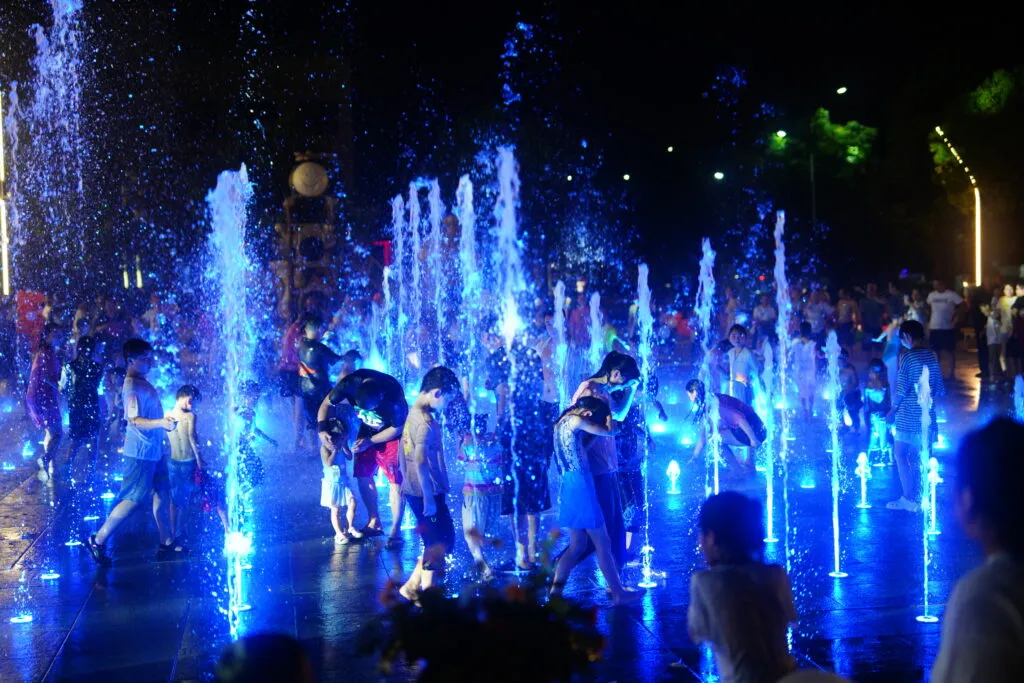
Internet of Things (IoT): Smart Fountain Ecosystem
Modern fountains are being networked with IoT-enabled devices for better control and monitoring:
Remote diagnostics detect pump issues, low water levels, or lighting failures in real time.
Weather-responsive systems adjust the height of jets or pause the show during strong winds.
Cloud-based scheduling allows operators to change routines for holidays, cultural events, or audience demographics.

Projection Mapping & Holograms
Water is now being used as a canvas:
Mist screens or water curtains act as translucent projection surfaces.
3D projection mapping combines light, sound, and geometry to tell stories across space and time.
Some systems are experimenting with laser-based holography that floats images above the fountain itself.
Visual Impact:
Imagine seeing a phoenix rise from the mist, wings aflame, timed perfectly to a crescendo in the music.
Sustainable Design
With eco-consciousness on the rise, emerging trends also prioritize green tech:
Closed-loop filtration to reduce water waste.
Solar-powered pumps and LEDs.
Rainwater harvesting systems to replenish fountains naturally.
This aligns aesthetics with environmental responsibility, especially in regions prone to drought.
AI-Driven Choreography
Algorithms are now used to generate new water-light-music routines, adapting shows in real time based on crowd size or mood.
Machine learning can analyze which sequences get the best audience reaction and evolve over time.
Outcome:
No two performances are ever quite the same.
These innovations are redefining fountains from static spectacles into living, adaptive environments—a fusion of tech, art, and public interaction. The fountain of the future is no longer something you just watch… it’s something you feel, shape, and co-create.
Come Feel the Rhythm of Water in Kazakhstan
From the heart of Astana to the serene parks of Ust-Kamenogorsk, Kazakhstan’s musical fountains offer more than just a visual treat—they’re an immersive fusion of culture, innovation, and emotion. Whether it’s jets dancing to traditional dombra melodies, lights painting the night sky, or water arcs mimicking the heartbeat of a symphony, these fountains are living works of art.
Don’t just watch the magic—step into it
Stroll through Nurzhol Boulevard as the Singing Fountain serenades you, witness cutting-edge choreography at the Astana Expo site, or experience interactive water shows that bring communities together under the stars.
Whether you’re a tech enthusiast, a culture lover, or just someone chasing beauty—you’ll find something unforgettable waiting by the waters.
Plan your journey to Kazakhstan and let the fountains move you
Because here, music doesn’t just play… it dances.
Want help mapping a fountain tour route or finding the best times to visit? I’ve got you covered!


